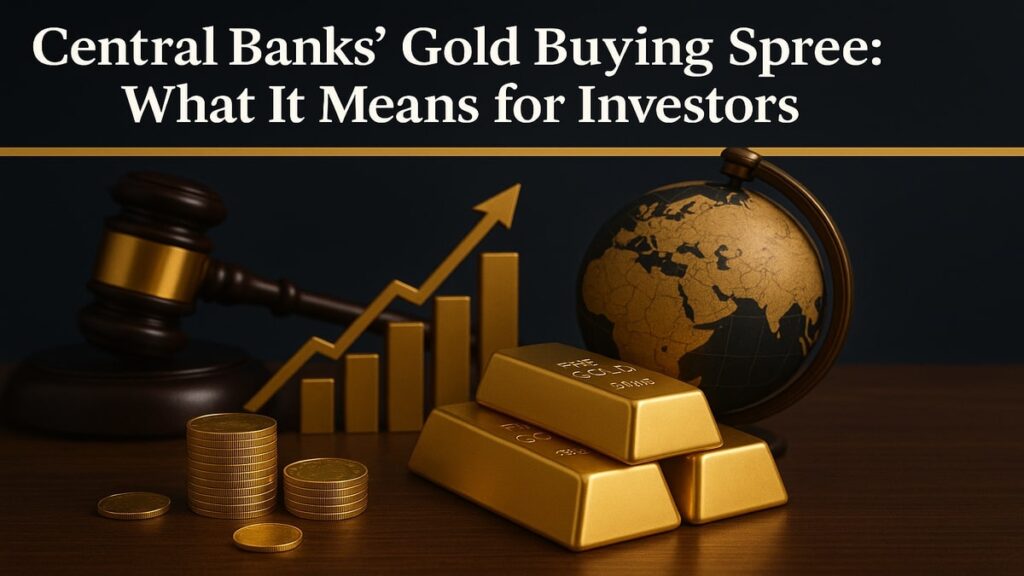Introduction: when policy makers become price makers
For years, investors drove most of gold’s moves. In 2024–2025, central banks joined and in many months led the bid. The World Gold Council reports 166 tonnes of net central-bank purchases in Q2 2025 alone, with survey data showing most reserve managers still plan to add. That steady, price-insensitive demand is a structural tailwind for bullion. (World Gold Council)
Why central banks are buying more gold
1) Reserve diversification
Many reserve managers want less exposure to any single currency. Gold is neutral, liquid, and outside another country’s liability structure. WGC and IMF data show diversification is ongoing, with official holdings rising through 2025 and broader FX-reserve composition slowly shifting. (World Gold Council)
2) Geopolitics and sanctions risk
Gold can’t be frozen by sanctions. In an era of great-power competition and trade frictions, that matters to policy makers as much as to investors. The European Central Bank also highlighted how official-sector demand has risen to a historically high share of total gold demand. (European Central Bank)
3) Portfolio hedging for the official sector
Just like private portfolios, sovereign balance sheets hedge inflation, currency swings, and tail risks with bullion. Monthly WGC updates show ongoing net additions into late 2025. (World Gold Council)
What official buying means for price
When central banks buy, dips tend to be shallower and rallies stickier. In 2025, that backdrop coincided with record prices as safe-haven flows and policy expectations amplified the move. Analysts now tie a meaningful part of the rally to persistent official demand—one reason many banks keep bullish 2026 targets. (Reuters)
Investor playbook: how to align with the trend
Focus on metal you can defend in an audit. When prices run, “cheap” offers proliferate often with weak paperwork. Prioritize:
- Verified provenance (chain of custody, export docs, assays).
- Assay-on-arrival settlement at a mutually approved refinery.
- LBMA-linked pricing and enforceable contracts.
- Clear logistics with insurance and accountability.
The Congo Rare Minerals advantage
Congo Rare Minerals (CRM) lets you buy at the source, not through stacked intermediaries:
- The Source Advantage: Direct from licensed DRC mines cut layers, cut markups, keep the audit trail intact.
- Guaranteed provenance: Full documentation and independent refinery assay on delivery (Dubai, Switzerland, Europe, China, USA).
- Compliant export corridor: Secure routing via Uganda supports efficient clearance and predictable timelines.
- Ethical alternative: We acknowledge regional risks and operate as a legal, transparent channel that supports local development.
Strategic context to this supply: The DRC is widely cited with ~$24 trillion in untapped mineral wealth, and officials repeatedly note about 90% remains unexploited a long runway for source-direct partnerships. (African Business)
FAQ: central-bank buying and your allocation
Are central banks really still buying at these prices?
Yes. Net purchases were 166t in Q2 2025, and WGC’s 2025 survey shows broad intent to keep adding over the next year. (World Gold Council)
Does official buying guarantee higher prices?
Nothing guarantees price, but steady, policy-driven demand can support floors and shorten drawdowns, which is why many banks keep constructive 2026 outlooks. (Reuters)
What’s the best way to buy in this environment?
Stage entries, insist on assay-based settlement, and buy source-direct to avoid hidden markups and provenance risk.
Bottom line
Central-bank demand is a structural tailwind and it’s not going away. If you’re increasing exposure, make sure your gold is documented, deliverable, and defensible.
Stop paying for middlemen and uncertain paperwork. Secure your allocation at the source.
Contact Congo Rare Minerals to discuss volumes, routes, and current LBMA-linked terms for delivery to your preferred refinery.

